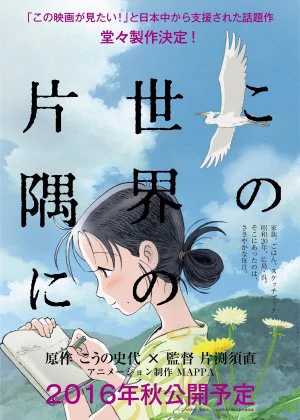In This Corner of the World
The moment I saw the poster for Sunao Katabuchi's In This Corner of the World [Kono Sekai no Katasumi Ni], I knew there was a big chance that I was going to like this film. It radiates a certain "harmless quality" vibe that's somewhat reminiscent of Studio Ghibli's work. The fact that it's a WWII drama seen from the point of view of the Japanese who stayed behind only tightens the connection. After watching the film though, I feel there's a little more to Katabuchi's latest, than its surface-level similarities to Grave of the Fireflies suggested.
![screen capture of In This Corner of the World [Kono Sekai no Katasumi Ni]](/thumbs/img/articles/1200xauto/corner-world-1.webp)
Katabuchi never directed any films for Ghibli, but he did work under Miyazaki as assistant director for Kiki's Delivery Service. It's not all that surprising then that at least a small part of Ghibli's trademark style rubbed off on him. Katabuchi proved himself a competent feature film director before, with Princess Arete and Mai Mai Miracle, but In This Corner of the World raises the bar considerably. The film itself is an adaptation of Fumiyo Kono's manga, but it's Katabuchi's contributions and direction that turned this into such a successful adaptation.
In This Corner of the World is a pretty mellow and pacifist film, still some people might end up being offended by it simply because it doesn't openly and directly condemn the Japanese involvement in WWII. It's a little absurd, but other war-related films like Grave of the Fireflies and The Wind Rises had to deal with similar criticism, so who knows. Ignore it though, and you'll find a touching story about how regular people see their lives destroyed because governments lack the common sense to avoid armed conflict.
The film tells the story of Suzu, a young and somewhat naive girl growing up near Hiroshima. She is married off to a boy in Kure and moves in with her new family immediately after, leaving behind her carefree life as an artist while taking over many of household chores. She takes well to her new life, even though she can be a little clumsy at times. But then the war breaks out and people's lives are thrown off course. Suzu never loses her positive disposition though, even when it's getter harder and harder to make ends meet.
![screen capture of In This Corner of the World [Kono Sekai no Katasumi Ni]](/thumbs/img/articles/1200xauto/corner-world-2.webp)
On a visual level, In This Corner of the World's holds the middle between Ghibli's popular style and the more watercolor-like approach of Isao Takahata's latest films. It creates a soft, warm and beautiful aesthetic that is extremely pleasant to look at. The art style isn't too detailed or complex, but it's not as abstract or experimental that it will push more traditional animation fans away. There are two more innovative sequences that break away from the rest of the film, but both are self-contained and rather short. The animation itself is top-notch too. Not abundant or overstated, but subtle and to the point. A great example of how you can achieve a lot with a little.
The music is a pretty snug fit for the visuals. Soft piano melodies and gentle strings make up most of the score, adding to the already sweet and comfortable atmosphere. The music is used sparingly and most of the time it's just ambient noises trickling through, but those effects help to create a relaxing mood. It's the dub that has the biggest impact though. Rena Nounen did a tremendous job voicing Suzu, giving her what I presume is a local dialect and adding lots of character to the part in the process. Her voice shapes the character, which is rare even for an animation. I noticed there's also an English dub floating around, but you'd be mad to pick that one over the original.
![screen capture of In This Corner of the World [Kono Sekai no Katasumi Ni]](/thumbs/img/articles/1200xauto/corner-world-3.webp)
While In This Corner of the World appears sugary sweet, especially during its first hour, the film also has a surprising bite. The depiction of Suzu's past might be a little too rosy and idyllic and at first the film may feel a bit too episodic, but it soon dawns that the entire film is basically one big countdown to August 6, 1945. The day the bomb was dropped on Hiroshima. The irregular jumps in time quickly become distressing, as our sympathy for Suzu grows and the inevitable draws closer and closer. And while the film might not aim for Grave of the Fireflies-like sentiment, In This Corner of the World doesn't pull its punches in the least.
While there's definitely a political, anti-war take-away, I still felt the film was as much about Suzu as it was about the impact of war on the common folk. She's an amazing character, sweet but a little grumpy, positive but a little clumsy and head-strong when need be. It's actually quite rare to see a well fleshed-out character that's genuinely pleasant to hang with, so when the war finally hits and her life gets turned upside down the dramatic impact is considerable.
Sunao Katabuchi crafted a gentle, warm and endearing film, but not without its share of sharp critique and gut-wrenching drama. It may start off sweet, and it may look the part, but underneath there's anger, disappointment and suffering, though well hidden beneath the positive disposition of its main character. It's by far the best film Katabuchi has directed, but more importantly it's another sign that the anime feature market is regaining its critical standing.
